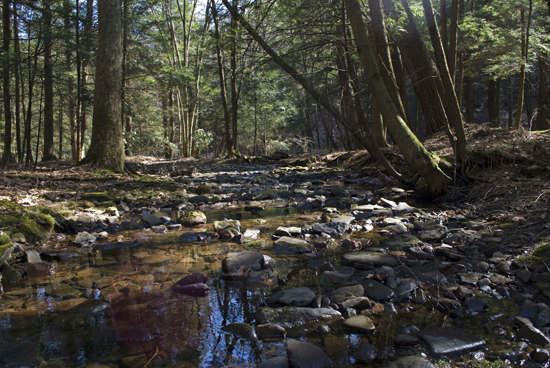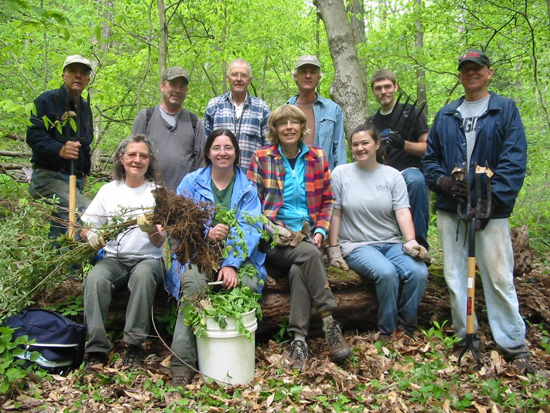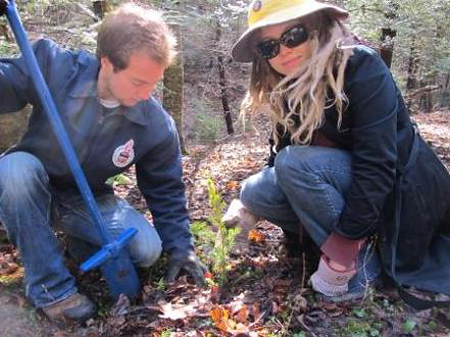Watershed Wednesday: Savage River Watershed Association (Garrett County, Md.)
SRWA helps monitor and protect this pristine western Maryland river.
Growing up, Carol McDaniel spent a summer or two playing in northeast Ohio’s streams. Catching salamanders and crayfish helped her develop affection for the outdoors. After working 30 years as a nurse in Baltimore, McDaniel is now reliving her childhood in western Maryland, where she monitors streams, searches for macroinvertebrates and mobilizes volunteers with the Savage River Watershed Association (SRWA).

“We were always into the outdoors even though we didn’t work outdoors,” McDaniel says. Her husband, Joe, is a retired scientific computer programmer. “When it got to the point where we were trying to retire, we wanted to pick a place that our kids would want to visit.”
The place they chose was a home on top of a ridge in the Youghiogheny River watershed. The Youghiogheny is not part of the Chesapeake Bay watershed (the “Yough” – pronounced yah-k – flows to the Mississippi River), but it borders the Savage River watershed, one of the most pristine corners of the Chesapeake region.
The Savage River watershed is the largest natural remaining native brook trout habitat in the Mid-Atlantic. Brook trout are able to live in the majority of the 30-mile-long Savage River and its tributaries because the water is highly oxygenated and stays cool (below 68 degrees) year-round. Because brook trout have such steep habitat requirements, they are used as an indicator species. More brook trout in a stream tells scientists that the water is healthy.
But the watershedmay not be healthy much longer. What McDaniel describes as the “inevitable” Marcellus Shale drilling poses a threat to the region. One spill, she says, and the brook trout would be gone.
Another constant issue is landowner habits, such as allowing cows to defecate in steams. Such actions spread beyond private property and into the river system. This problem is particularly serious in rural areas such as Garrett County, where residents may own large parcels of land.
Fortunately, residents involved with SRWA are working together to mitigate and monitor the river system. Since the organization first began (in 2006, with an ad in the local paper calling for “stream monitoring volunteers”), members have grown to include trout fishermen, professors and students at nearby Frostburg State University, part-time residents who vacation in the region, farm landowners, and interested streamside property owners. These diverse perspectives are a tremendous benefit to the organization, as input from every one of watershed's 1,500 residents is essential if the Savage River is to remain healthy.
“We're trying as an organization to walk a delicate line, and not be perceived as a radical tree hugging group,” explains Annie Bristow, SRWA treasurer. “We really want landowners to be on board and for us to be perceived as an organization that can help them.”
Most recently, a couple came to a SRWA meeting asking for the group’s assistance. Their property along the Savage River had begun to rapidly erode due the massive snowmelt during the winter of 2010. SWRA received a grant, and restoration is to begin in spring of 2013.

(Image courtesy Savage River Watershed Association)
Marcellus Shale: Preparing for the “inevitable”
“I try to have hope, but everyone keeps telling me that this is going to happen.” Bristow is referring to natural gas extraction from the Marcellus Shale region in western Maryland. “I guess it is inevitable.”
The Marcellus Shale is a sedimentary rock formation in the Appalachian province that contains deep underground deposits of natural gas. Its use is fairly widespread; according to USGS, in 2009, 25 percent of the energy consumed for electricity, cooking and heating the United States came from natural gas.
As the demand for affordable energy sources increases, energy companies have begun to drill through the rock to extract natural gas. Widespread concern about the environmental effects of this “fracking” process has led to regulations against it in Maryland. Although this protects Maryland's water resources, the bordering states of Pennsylvania and West Virginia have fewer natural gas drilling regulations.
“There are sections of Garrett County where there are only nine miles between Pennsylvania and West Virginia, so Maryland (in between) is still affected greatly,” explains Bristow. “There's drilling sites in West Virginia and Pennsylvania that affect our tributaries, and those streams are already being monitored.”
SRWA seeks to monitor the health of streams before drilling occurs to develop a “baseline” for post-drilling comparison. After undergoing rigorous training by the Maryland Department of Natural Resources, Bristow and McDaniel trained SRWA volunteers to measure water quality indicators such as temperature, pH and conductivity on 13 sites along the Savage River and its tributaries.
While SRWA and Maryland DNR have been monitoring streams long before the Marcellus Shale debate began, the potential effects of natural gas drilling serve as a new incentive to keep an eye on the Savage River.
“I think when they do begin drilling, we are going to see people concerned about the watershed coming out of the woodwork,” says McDaniel.
Reforesting streamsides
One reason the Savage River's water temperature is cool enough for brook trout is the shade provided by eastern hemlock trees along its banks. But these dense hemlock forests may not survive much longer; a tiny insect known as the hemlock woolly adelgid is sucking sap from hemlock trees and killing them. Just as SRWA is preparing for the inevitable Marcellus Shale development, volunteers are also expecting streamside hemlocks to disappear due to this invasive sap-sucker.
To avoid eroding soil, increased water temperatures and other perils that come with bare stream banks, SRWA has planted 4,000 red spruce trees along the Savage River’s shoreline. This spring, they plan to plant 500 more.

(Image courtesy Savage River Watershed Association)
Rerouting farm ponds
If you drive on Interstate 68 into Garrett County, you'll see a number of farms, each with its own accompanying man-made pond.
“When this area was turned into farmland after it was logged at the turn of the last century, every farmer dug a pond,” explains McDaniel.
Ponds and other unshaded, open areas quickly heat up in warmer months. When these ponds are attached to the Savage River and its tributaries, they dump warm water into the system. This affects water quality, water temperature, and consequently, brook trout.
“One of the things we would like to start doing is to take these ponds off the stream at no expense to the farmer or landowner,” explains McDaniel.
SWRA supported a project that rerouted a pond belonging to the City of Frostburg. “We turned the pond into a three or four acre wetland and re-routed the stream,” says McDaniel. “Within two or three months, there were baby trout in the stream!”
More from the Savage River watershed:
- The Marcellus Shale Coalition is made up of advocates for responsible natural gas development
- Fish, swim and hike at New Germany State Park
- Camp, canoe and hunt in Savage River State Forest

Comments
After (or better yet, before) you have looked at the industry-sponsored Marcellus Shale Coalition web site, be sure check out CitizenShale.org, a group of western Maryland citizens advocating far more study of the ramifications of drilling before allowing it to proceed in this state.
"Then the coal company came with the world's largest shovel
And they tortured the timber and stripped all the land
Well, they dug for their coal till the land was forsaken
Then they wrote it all down as the progress of man." John Prine
Used to sing this song around the campfire many nights on the Savage River. Coal-gas not much difference. My grandfather was a coal miner in Shaft, MD. Still trying to clean up AMD. So, long my beloved Savage River, I loved thee like a brother.
Thank you!
Your comment has been received. Before it can be published, the comment will be reviewed by our team to ensure it adheres with our rules of engagement.
Back to recent stories